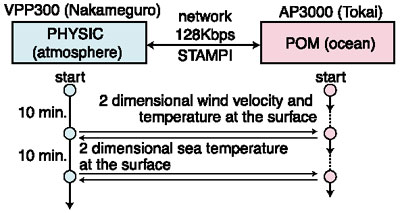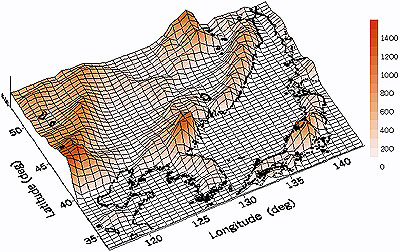 |
||
|
 |
Fig. 10-2 The computational domain including the Japan sea |
 |
||
|
| In order to understand various meteorological and/or oceanic phenomena we should consider the strong interaction between the atmosphere and the ocean. For this reason it is very important to carry out numerical simulation by taking into account the interaction between them. It is, however, rather difficult to construct such a simulation program from the viewpoint of modeling of the physics as well as the viewpoint of the computing techniques. We have already developed the prediction system of radioactivity dispersion SPEEDI based on the simulation program of atmospheric motion and used it practically for the analysis of the environmental pollution by radioactive materials emitted at the occasion of an accident of an atomic power plant. To realize a prediction with higher accuracy we have incorporated the oceanic phenomena into the SPEEDI program. The source of the difficulty to construct such a synthetic program is that the time scales of the meteorological and oceanic phenomena differ very much, where the oceanic phenomena evolve very slowly in comparison with the meteorological phenomena. We have, nevertheless, succeeded in constructing such a simulation program because we could carry out the high-speed parallel computation on the basis of the STAMPI library which we had developed. By using the STAMPI library different kinds of numerical programs can be run on different kinds of computers which deal most effectively with the assigned numerical processes (Fig. 10-1). We have carried out a simulation for the computational domain including the Japan sea (Fig. 10-2) and obtained the satisfactory result (Fig. 10-3). From the figure it is seen that the surface flow of sea water is determined by the wind force, which governs the dispersion of radioactive materials in the ocean. It is also seen from Fig. 10-3 that the direction of the surface flow of the sea water coincides with the direction of the wind governed by the high mountains in the northern part of Korean peninsula. |
| Reference S. H. Lee* et al., Numerical Studies on the Interaction between Atmosphere and Ocean Using Different Kinds of Parallel Computers, SNA-2000, Sep. 4-7, 2000, Tokyo, Japan, ES-G2 (2000). *post doctoral fellow |
| Select a topic in left column |  |
| Persistent Quest - Research Activities 2001 Copyright(c) Japan Atomic Energy Research Institute |